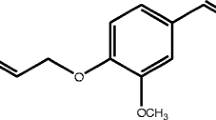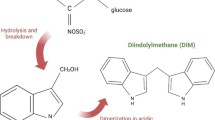Abstract
3-(4′-Geranyloxy-3′-methoxyphenyl)-2-trans propenoic acid (4′-geranyloxyferulic acid, GOFA) 1 is an oxyprenylated ferulic acid derivative that has been extracted for the first time in 1966 from the root and bark extracts of Acronychia baueri Schott (Fam. Rutaceae). In the last decade the pharmacological properties of the title compound began to be characterized, revealing its valuable potentialities as an anti-inflammatory and anti-tumor agent. In this context the aim of this review article is to report the insofar described biological effects of 4′-geranyloxyferulic acid. Data collected during the recent years indicates that 1 is an effective dietary feeding colon cancer chemopreventive agent in vivo. When administered to animals, in which colon adenoma and adenocarcinoma have been induced by the administration of azoxymethane in the diet, as a large bowel delivered prodrug linked to dipeptides, or as an inclusion complex in cyclodextrins, or coupled to known anti-inflammatory agents like L-NAME, a protective effect on colon cancer growth and development have been recorded. Recent studies on the natural occurrence of 4′-geranyloxyferulic acid, showed the presence of this oxyprenylated secondary metabolite in widely consumed edible fruits and vegetables like citrus fruits and their phytopreparations.
Similar content being viewed by others
References
Curini M, Epifano F, Genovese S (2005) Synthesis of a novel prodrug of 3-(4′-geranyloxy-3′-methoxyphenyl)-2-trans-propenoic acid for colon delivery. Bioorg Med Chem Lett 15:5049–5052
Curini M, Epifano F, Genovese S, Marcotullio MC, Menghini L (2006) 3-(4′-Geranyloxy-3′-methoxyphenyl)-2-trans propenoic acid: a novel promising cancer chemopreventive agent. Anticancer Agents Med Chem 6:571–577
Epifano F, Genovese S, Menghini L, Curini M (2007a) Chemistry and pharmacology of oxyprenylated secondary plant metabolites. Phytochemistry 68:939–953
Epifano F, Genovese S, Sosa S, Tubaro A, Curini M (2007b) Synthesis and anti-inflammatory activity of 3-(4′-geranyloxy-3′-methoxyphenyl)-2-trans propenoic acid and its ester derivatives. Bioorg Med Chem Lett 17:5709–5714
Epifano F, Curini M, Genovese S, Blaskovich M, Hamilton A, Sebti SM (2007c) Prenyloxyphenylpropanoids as novel lead compounds for the selective inhibition of geranylgeranyl transferase I. Bioorg Med Chem Lett 17:2639–2642
Genovese S, Foreman JE, Borland MG, Epifano F, Gonzalez FJ, Curini M, Peters JM (2010a) A natural propenoic acid derivative activates peroxisome proliferator-activated receptor-β/δ (PPARβ/δ). Life Sci 86:493–498
Genovese S, Epifano F, Carlucci G, Marcotullio MC, Curini M, Locatelli M (2010b) Quantification of 4′-geranyloxyferulic acid, a new natural colon cancer chemopreventive agent, by HPLC-DAD in grapefruit skin extract. J Pharm Biomed Anal 53:212–214
Genovese S, Curini M, Gresele P, Corazzi T, Epifano F (2011a) Inhibition of COX-1 activity and COX-2 expression by 3-(4′-geranyloxy-3′-methoxyphenyl)-2-trans propenoic acid and its semi-synthetic derivatives. Bioorg Med Chem Lett 21:5995–5998
Genovese S, Epifano F, Curini M, Menger D, Zembruski NCL, Weiss J (2011b) In vitro effects of natural prenyloxycinnamic acids on human cytochrome P450 isozyme activity and expression. Phytomedicine 18:586–591
Genovese S, Epifano F, Fiorito S, Curini M, Marrelli M, Menichini F, Conforti F (2013) Conjugation of L-NAME to prenyloxycinnamic acids improves its inhibitory effects on nitric oxide production. Bioorg Med Chem Lett 23:2933–2935
Genovese S, Epifano F, Carlucci G, Fiorito S, Locatelli M (2014) HPLC analysis of 4′-geranyloxyferulic and boropinic acids in grapefruits of different geographical origin. Phytochem Lett 8:190–192
Miyamoto S, Epifano F, Curini M, Genovese S, Kim M, Ishigamori-Suzuki R, Yasui Y, Sugie S, Tanaka T (2008) A novel prodrug of 4′-geranyloxyferulic acid suppresses colitis-related colon carcinogens. Nutr Cancer 60:675–684
Peters JM, Gonzalez FJ (2009) Sorting out the functional role(s) of peroxisome proliferatoractivated receptor-β/δ (PPARβ/δ) in cell proliferation and cancer. Biochim Biophys Acta 1796:230–241
Prager RH, Thregold HM (1966) Some neutral constituents of Acronychia baueri. Aust J Chem 5:451–453
Rao CV (2004) Nitric oxide signalling in colon cancer chemoprevention. Mutat Res 555:107–119
Shimizu M, Kochi T, Shirakami Y, Genovese S, Epifano F, Fiorito S, Mori T, Tanaka T, Moriwaki H (2014) A newly synthesized compound, 4′-geranyloxyferulic acid–N(omega)-nitro-l-arginine methyl ester suppresses inflammation-associated colorectal carcinogenesis in male mice. Int J Cancer. doi:10.1002/ijc.28718
Tanaka T, de Azevedo MBM, Duran N, Alderete JB, Epifano F, Genovese S, Tanaka M, Tanaka T, Curini M (2010) Colorectal cancer chemoprevention by 2 β-cyclodextrin inclusion compounds of auraptene and 4′-geranyloxyferulic acid. Int J Cancer 126:830–840
Terlizzi M, Casolaro V, Pinto A, Sorrentino R (2014) Inflammasome: cancer’s friend or foe? Pharmacol Ther 143:24–33
Watanabe K, Kawamori T, Nakatsugi S, Wakabayashi K (2000) COX-2 and iNOS, good targets for chemoprevention of colon cancer. BioFactors 12:129–133
Author information
Authors and Affiliations
Corresponding author
Rights and permissions
About this article
Cite this article
Epifano, F., Fiorito, S., Taddeo, V.A. et al. 4′-Geranyloxyferulic acid: an overview of its potentialities as an anti-cancer and anti-inflammatory agent. Phytochem Rev 14, 607–612 (2015). https://doi.org/10.1007/s11101-014-9377-x
Received:
Accepted:
Published:
Issue Date:
DOI: https://doi.org/10.1007/s11101-014-9377-x




